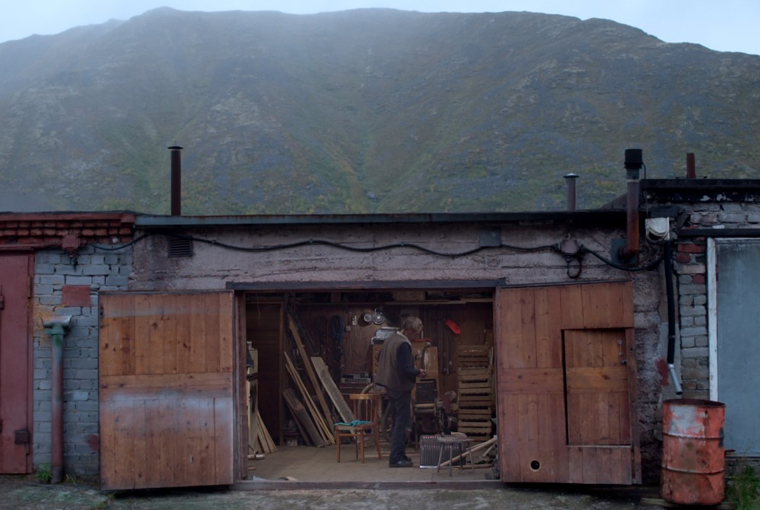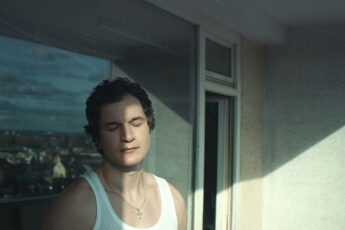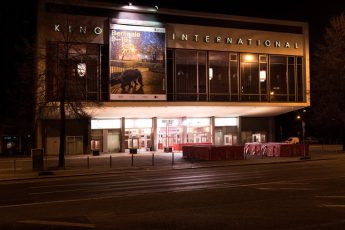Something in the Woodshed
Natalija Yefimkina’s Garage People (Garagenvolk, 2020)
Vol. 103 (March 2020) by Zoe Aiano
The skyline of the typical post-Soviet city has now become a reasonably familiar image, with its vast complexes of identikit apartment blocks, often in a state of disrepair but not without a certain aesthetic appeal. Less well known is the phenomenon of the sprawling conglomerations of garages found on the outskirts of Russian towns. These particular garages aren’t generally used for storing cars, but rather serve as intimate quarters for the pursuit of a variety of personal endeavors, whether as means of generating income, as a hobby or something in between.
Some of the activities presented in Natalija Yefimkina’s debut documentary Garage People are relatively unsurprising, such as woodworking, repairs and stripping down metal objects for parts and materials. Inevitably, there is also a literal garage band. Others are less expected, such as the burly man who looks something like a cliché of a tough Russian sailor but turns out to be a breeder and dealer of quails within his own four wooden walls. Perhaps the most poetic instance is the grandfather who spent decades digging multiple floors within his space, not to any particular end but simply out of impulse and possibly compulsion. Indeed, the film opens touchingly with him passing the garage on to his grandson as quite probably the family’s greatest asset.
Especially in terms of the exteriors, Yefimkina often adopts a stylized framing with carefully composed static wide shots that add an element of absurdism and accentuate the juxtapositions between the adjoining units. Often, we are only given teasing throwaway glimpses, such as the woman seemingly breeding dogs for show. One of the most effective examples of this depicts a row of garages with open doors and their inhabitants busy at work, including a man who disappears into the ground by means of a lift, something that is never explained nor revisited.
In this respect, the film’s most obvious point of comparison is Ulrich Seidel’s exploration of the bizarre goings on to be found in the basements of Austria, In the Basement (2014), which consists of a number of highly stylized and unsettling vignettes. Unlike Seidel, however, Yefimkina’s chooses to humanize her characters rather than objectify them as caricatures. Accordingly, the camera loses its formalism and grows loser and more intimate within the internal spaces and when focusing on the individuals. Some of these moments are truly remarkable in terms of the intimacy achieved by the crew, such as a poignant tête-à-tête between a frustrated wife and her alcoholic husband, and a massive drunken brawl.
Each of her protagonists reveals telling details about the state of contemporary Russia. Intriguingly, the resident carpenter spends his time carving elaborate Orthodox icons, yet considers himself an atheist. Even more revealing is his interaction with a local priest, who is opening a new church bank-rolled by the local mine – highlighting the interconnection between religion and industry – and who, when humbly requested to make a donation for the work he commissioned, pointedly declines. The young members of the resident rock band also offer glimpses into their aspirations and dreams, revealing the limited prospects on offer in their hometown. Sure enough, before long, only one band member is left after the others have all moved away. The continued reappearance of portraits of Putin as another ambiguous but inevitable icon is also very indicative of the prevailing mood.
On the one hand, this opportunity for “a garage of one’s own”, with four walls in which to take refuge and indulge in the unfettered pursuit of individual interests, would be the envy of many an urban dweller in increasingly cramped metropolises throughout the world. Moreover, this model of post-Soviet garage offers two big advantages over its most obvious Western counterpart, i.e. the classic Anglo-Saxon “men’s shed”. Firstly, the latter generally requires ownership of a garden, which automatically precludes a large section of the population from ever having one. Second, it manages to create a community out of the multitude of individual endeavors taking place in parallel, as opposed to the inherent isolationism of the garden shed (although admittedly, the solitary nature may well be part of the appeal for some). Nevertheless, while it celebrates the garages and their inhabitants to a certain degree, the film also makes it palpably clear that these pockets of freedom and opportunity are essentially created as the only possible outlet in an otherwise massively constrained society, and that, such being the case, the men in their sheds are ultimately getting a bad deal. (Unsurprisingly, the garages are an overwhelmingly male space – the women are predominantly left with dominion over/confinement in the domestic sphere).
Looming in the background of both the city and the film is the mine. Although the exact identity of the city is purposely not given in order to heighten the film’s relevance to the Russian experience as a whole, it is highly likely that it was purpose built, or in any case, drastically increased, to accommodate the workers. The mine remains the only source of employment, yet the small sample of residents depicted suffice to make it palpably clear how high the rate of chronic work-related illness is, including both physical and psychological. As the tragic backstories of the various characters unfurl, the mystery of why some of these men would choose to eke out a living in such a tenuous manner is gradually solved. These parallel, semi-legal economies taking place in the shadow of the mine serve as a damning testament to a societal model that places no value on the well-being of its proletariat.
This seems to be the core message of the film, which it delivers subtly but damningly, luring viewers in with quirkiness only to disarm them with humanity, striking the right balance between playfulness and tragedy without patronizing either its viewers or its protagonists.




Leave a Comment